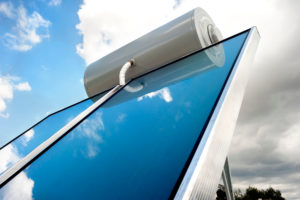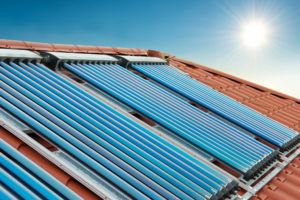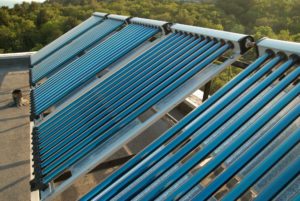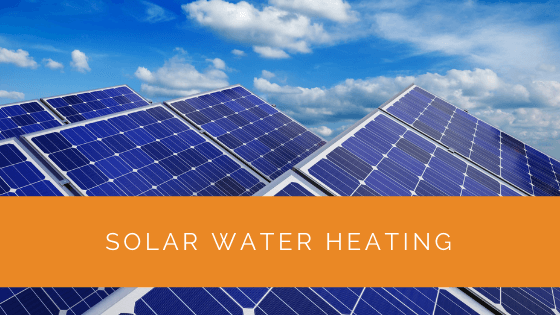Solar water heating systems are benign alternatives to conventional heating solutions. They can save a considerable amount of your electricity bills by harnessing heat from the sun.
However, a solar water heating system can seem like a substantial investment from a customer’s perspective. So, would it help to install solar panels to get a regular hot water supply? Also, will solar water heating work in your locality?
We bring you a comprehensive guide based on the solar hot water system to answer all these questions. This guide includes crucial info about solar water heaters, the workings of the system, and how you can profit from such advanced hot water systems.
Contents
- 1 Key Takeaways
- 2 Solar Water Heating System Working
- 3 Solar Thermal Water Heating Components
- 4 Solar Water Heating Systems Economics
- 5 Factors To Consider While Installing A Solar Water Heating System
- 6 Frequently Asked Questions
- 7 Case Study: Maximising Efficiency with Solar Water Heating
- 8 Expert Insights From Our Solar Panel Installers About Solar Water Heating Systems
- 9 Discover the Power of Solar with Solar Panels Network
- 10 Endnotes
Key Takeaways
- Solar water heating systems harness the sun’s energy to heat water, reducing electricity bills and carbon footprints.
- Understanding the components, such as solar collectors, pumps, storage tanks, and heat exchangers, is essential for cost-effective installation.
- Factors like the type of solar system, roof orientation, available rebates, and budget should be considered when installing a solar water heating system to maximise savings and efficiency.
Solar Water Heating System Working
Understanding the workings of solar heating in depth can encourage people to reduce their carbon footprint in a much-needed era.
Step 1: Solar Collectors
Solar collectors are panels that a solar contractor fits on your roof. The function of these components is straightforward.
- Solar panels capture energy from the sun
- This energy in the form of heat increases the temperature of the water
These solar collectors contain tiny tubes. Water passes through these tubes, and the heat from the sun does the job of heating the domestic water.
Step 2: Water Transport
The solar system uses pipes that carry hot water from collectors and pass through a storage tank.
A coil is responsible for the heat transfer of the domestic hot water system. Depending on your requirements, the arrangement of this coil and pipe network can vary.
The pipes transport hot water to the required parts of your house. Overall, renewable energy from the sun is utilised to heat the water.
Solar Thermal Water Heating Components
Before installing a full-proof solar water heating system, it is imperative to have basic knowledge about its functioning parts.
This knowledge proves helpful as domestic users can skip installing some items to reduce costs. Also, fewer items require low maintenance and prove to be potential money savers.

Solar Collector
Using solar power to heat water requires properly installing energy-gathering items like collectors. Depending on the construction, materials and manufacturing method, the cost of these panels varies considerably.
The solar thermal collectors use conduction, convection and radiation to heat water. Generally, two types of collectors are prominent in modern thermal systems.
Flat Plate Collectors
In these collectors, the glass directly faces the sun. The most significant benefit of these collectors is flexibility. You can fit these collectors on the roof or integrate them directly.
Flat plate collectors generally have a distinct set of pipe arrangements. Depending on their alignment, the function of these pipes varies.
- Headers are horizontal pipes that serve collection purpose
- Risers are small vertical tubes serving the purpose of heat exchange
An anti-freeze fluid from the heat exchanger is pumped to the flat plate collector’s headers. The fluid enters the bottom header and collects heat, eventually travelling to the top header pipe.
The flat plate collectors are durable due to tempered glass construction. Thus, this type of collector is ideal for installation if you reside in a region with constant hailstorms.
Evacuated Tube Collectors
Compared to flat plate types, tube collectors are more efficient and compact. These collectors are constructed from a series of glass tubes. The heat insulation in these tubes is the reason for their high efficiency.
The heat is trapped inside the tubes due to a vacuum effect. In other words, the vacuum creates heat insulation for the flowing liquid. These collectors are beneficial for heating a high volume of water.
The inner glass tubes of tube collectors are coated with a thermal absorber.
Solar Pump
Simply put, a solar pump circulates hot water from the collector to the storage tank and thermal regulator. This pump is evident in most active solar water heating systems.
A pump can prove propitious if you live in regions where the surrounding temperature doesn’t fall to a freezing range. Also, solar pumps are beneficial for installing indirect circulation hot water systems.
A geyser pump is the most common component in some solar water heating systems. However, their inclusion is subjective and depends on the area and region of the installed system.
Storage Tank
A storage tank or cylinder accumulates hot water from the collectors when not required. The storage tanks can be mounted at different positions depending on their utility.
- Roof mounting: In a thermosiphon system, a tank is mounted above collectors
- Split mounting: The tank is mounted on the ground and requires a pump for circulation
It’s a cliche that hot water floats above cold water. Hence, water from the top of a hot water cylinder is used for domestic or commercial purposes.
You can even insulate the storage tank to maintain hot water temperature for a prolonged period.
Heat Exchanger
This component transfers heat from hot water to the home water supply. Depending on the final requirement of the application, a heat exchanger can find a custom installation.
- A heat exchanger can be in the form of a tube or coil in the storage tank
- Tubes containing hot water can be enclosed in a metal casing outside the cylinder
Thus, solar thermal systems can use this component subjectively depending on the practicality of installation. During cold climates, an anti-freeze serves as a vital heat transfer fluid.
This fluid circulates in the solar heating system, protecting the collector from freezing. Hence, a heat exchanger is integral for energy transfer.
Solar Water Heating Systems Economics
ROI and feasibility are often essential points to assess the value of solar water heating systems.
Installing a solar water heating system can decrease your water heating costs by at least 50%. In the UK, solar water heating systems have an average lifespan of nearly 20 years.
Generally, a water-heating solar system can cost between £3,000 and £5,000. This cost takes the installation of all the vital components under consideration.
The initial investment varies on various factors given below.
- Occupancy
- Type of solar system
- Dwelling size
- Cylinder type
Annual Operating Cost Of Solar Water Heaters
Customers must pay attention to the payback period and estimated operating costs of solar thermal systems. Three parameters are crucial to calculate the reduction in your water heating bills.
- Auxiliary tank fuel type
- Local utility costs
- Solar energy factor
A solar energy factor (SEF) is the solar energy delivered by the system divided by the input gas or electrical energy. Generally, a higher SEF denotes an efficient solar thermal system. SEF ranges from 1 to 11, with a value of 3 being the most common.

Operating Cost For Electrical Auxiliary System
Annual operating cost (estimated) = 365 x (12.03/SEF) x cost of electricity (kWh)
The auxiliary electrical system is a power source for components of solar water heating. However, using pre-heated water in the system helps reduce energy bills to heat water using conventional sources like coal and electricity.
Operating Cost For Gas Auxiliary System
Annual operating cost (estimated) = 365 x (41045/SEF) x Fuel cost (BTU)
Here, BTU stands for British Thermal Unit. Usually, DIY hot water solar kits cost an average of £2,000. However, energy-saving from such a system is a cost-effective investment for any household or commercial firm.
Minimising Costs By A Solar Hot Water System
It would be best to have auxiliary energy to support components like the solar pump. In most cases, pumping costs become negligible over time.
Using renewable energy to save money depends on various factors. For starters, the type of solar water heating system, panel construction, angle of roof instalment, etc., plays a crucial role in savings per year.
If you use LPG to heat water, a solar water heating system can save around £90 per year. On the other hand, if you use gas central heating, expect the savings to hover around the £50 mark per year.
Usually, a solar water heating system has an average of 7 years warranty period. In addition, these systems require low maintenance and simple installation procedures.
Factors To Consider While Installing A Solar Water Heating System
Using the sun’s energy to heat water is a great way to minimise carbon footprint and contribute towards a greener planet. Energy-saving is a benefit of such renewable energy systems. However, as customers, each setup needs to identify factors to maximise these benefits.
Types Of Solar Heating Systems
At this time, to simplify your selection process, consider two major types of hot water heating systems.
- Direct (Open-loop) systems
- Indirect (Closed-loop) systems
Direct systems are cheaper than closed-loop setups. They rely on heat transfer as water circulates through the solar collectors. They do not have freeze and overheat protection by default. You must install a freeze extort pump and use freeze-tolerant collectors to nullify the lack of innate protection.
Indirect systems transfer heat from HTF to potable water by a heat exchanger. They offer overheating and freeze protection. Also, these types of solar heating systems are comparatively expensive.
Availability of Facing Roof
Generally, a south-facing roof is ideal for mounting solar thermal panels. This position absorbs a lot of solar energy and is conducive to achieving maximum efficiency.
Also, the solar panels should be away from the shadow. Typical sources of shadow are trees, high buildings and chimneys. A 30-degree angle roof can help achieve high exposure to solar energy.
Depending on your location and collector angle, this direction can change without affecting the heating efficiency. Moreover, flat plate and evacuated tube solar collectors are independent of their working principle.
Rebates And Tax Credits
You should check for government grants or incentives for renewable energy applications.
The Smart Export Guarantee (SEG) is the UK’s lone solar panel funding scheme. This scheme compels suppliers to provide export tariffs to solar panel customers.
If you are a domestic customer with a solar panel system of up to 5 MW, you can avail of the SEG benefits. Also, solar panels can now offer a 5% tax reduction under the new VAT system.

Money Required For Installation
Lastly, your budget is a vital factor when selecting a hot water solar system. You need to carry out periodic maintenance, although it is less stringent.
In most cases, a qualified solar installer can handle these requirements at reasonable costs. Solar kits for hot water heating can often save money compared to a full-proof solar water heating system.
Calculate crucial aspects for maximising your savings and reducing initial investment. The following pointers can save your initial costs.
- Calculate the capacity of your existing water heater
- Request an estimate from an experienced solar installer
- Enquire about the need for planning permission
- Have a precise idea of your current energy bills
Frequently Asked Questions
Do Solar Water Heaters Reduce Energy Bills?
In addition to reducing your carbon footprint, harnessing the sun’s energy through solar water heaters can reduce energy bills.
In some cases, you may need a backup heater. However, if you use an immersion heater, a solar panel setup can reduce the reliance on such electrical gadgets.
Does the Solar Hot Water System Work at Night?
The heating mechanism of this system works during the day. However, hot water is stored in an insulated tank. Thus, in the absence of the sun, hot water can be utilised as per requirement.
It is profitable to approach your local solar installer to get the best advice on insulation, heater, heat exchanger, and the type of solar water heating system.
How Hot Does Water from Solar Systems Get?
The temperature of hot water varies as per the sun’s intensity. On hot days, this system can supply water exceeding 60 degrees Celcius.
Importantly, you should pay attention to cylinder size and the number of evacuated tubes to achieve desired temperatures.
Case Study: Maximising Efficiency with Solar Water Heating
Background
Solar Panels Network was approached by a family in South East England seeking an eco-friendly solution to reduce their energy bills and carbon footprint. The family was interested in a solar water heating system to provide a reliable source of hot water throughout the year. They were particularly concerned about the system’s performance during the winter months, given the UK’s unpredictable weather.
Project Overview
The project involved installing a comprehensive solar water heating system tailored to the family’s specific needs. We proposed using a combination of evacuated tube collectors and a high-efficiency storage tank. The system aimed to deliver consistent hot water supply, significantly reduce energy consumption, and lower the family’s reliance on gas-powered heating systems.
Implementation
- Site Assessment: Conducted an initial site survey to determine the optimal placement of solar collectors, ensuring maximum sun exposure.
- System Design:
- Selected evacuated tube collectors for their superior thermal efficiency and ability to function in low-light conditions.
- Integrated a high-capacity storage tank with an internal heat exchanger to store and manage hot water effectively.
- Installation:
- Installed the evacuated tube collectors on the south-facing roof, at an optimal angle to maximise solar gain.
- Connected the collectors to the storage tank, ensuring seamless integration with the existing hot water system.
- Testing and Commissioning: Conducted thorough testing to ensure the system was fully operational and met the family’s hot water needs.
Results
- Energy Savings: The system provided approximately 60% of the family’s annual hot water needs, resulting in significant savings on energy bills.
- Reduced Carbon Footprint: The family reduced their carbon emissions by over 1.2 tonnes per year, contributing positively to their environmental goals.
- Year-Round Performance: The system’s design, featuring evacuated tube collectors, ensured reliable performance even during the winter months.
- Financial Payback: The system’s efficiency and energy savings projected a payback period of around 8 years, after which the family would benefit from free hot water generation.
Summary
This case study demonstrates the effectiveness of solar water heating systems in providing a sustainable and cost-effective solution for domestic hot water needs. The project’s success was underpinned by careful planning, quality component selection, and expert installation. The system not only delivered on its promise of energy savings but also significantly reduced the family’s environmental impact. At Solar Panels Network, we continue to deliver tailored renewable energy solutions, helping households transition to greener alternatives and enjoy long-term benefits. This project highlights the importance of expert guidance and customised solutions in maximising the potential of solar energy technologies.
Expert Insights From Our Solar Panel Installers About Solar Water Heating Systems
Solar water heating systems are a fantastic way to harness the sun’s energy efficiently. The technology behind evacuated tube collectors, for instance, offers excellent thermal performance, even in cloudy conditions. This makes them ideal for the UK’s variable weather, ensuring homeowners can consistently access hot water while reducing their reliance on fossil fuels.
Solar Thermal Specialist
Choosing the right components, such as a quality storage tank and an efficient heat exchanger, is crucial in maximising the benefits of a solar water heating system. Proper installation and regular maintenance are key to ensuring the system operates at peak efficiency, providing significant savings on energy bills over time.
Renewable Energy Consultant
When integrating solar water heating systems into a home, it’s essential to consider the building’s orientation and roof angle. A well-positioned system can maximise solar gain, ensuring that homeowners get the most out of their investment. This not only reduces costs but also enhances the system’s overall performance.
Solar Installation Expert
Discover the Power of Solar with Solar Panels Network
Are you navigating the world of solar installations? Look no further than Solar Panels Network, the UK’s trusted partner in harnessing the sun’s potential. Our dedication goes beyond just installations; we’re on a mission to transform how homeowners and businesses across the UK perceive and utilise energy. By choosing us, you’re reducing your carbon footprint and making a smart financial move that promises savings for years ahead. Contact us today and embark on your solar journey.
Endnotes
A solar water heating system is becoming highly conducive to maximising energy savings. Still, you should pay attention to the whole setup before installation.
Generally, these systems require periodic but low maintenance and are pretty robust. At this time, you can expect around 1500 kWh of heat per year from a domestic solar hot water system. So, a solar thermal system can prove a handy alternative to LPG and electrical heating sources.
About the Author
Solar Panels Network stands at the forefront of solar energy solutions, driven by a team of seasoned solar engineers and energy consultants. With over decades of experience in delivering high-quality solar installations and maintenance, we are committed to promoting sustainable energy through customer-centric, tailored solutions. Our articles reflect this commitment, crafted collaboratively by experts to provide accurate, up-to-date insights into solar technology, ensuring our readers are well-informed and empowered in their solar energy decisions.

